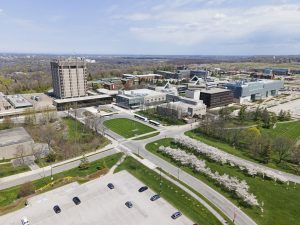 Brock University Kinesiology Professor Stephen Cheung (right) and master’s student Johnathan Ljubanovich in a unique chamber at the University’s Environmental Ergonomics Lab that can simulate a wide range of temperatures, humidity and oxygen levels, allowing researchers to measure what happens physiologically when exercising in extreme environments.
Brock University Kinesiology Professor Stephen Cheung (right) and master’s student Johnathan Ljubanovich in a unique chamber at the University’s Environmental Ergonomics Lab that can simulate a wide range of temperatures, humidity and oxygen levels, allowing researchers to measure what happens physiologically when exercising in extreme environments.After what scientists have deemed Earth’s hottest month on record, the impact of extreme heat is being felt more than ever across the globe.
As temperatures continue to rise, Brock University Kinesiology Professor Stephen Cheung is offering insight into how the body responds to heat and steps that can be taken to stay cool through summer’s remaining weeks.
“There is a big danger whenever there is a sudden heat wave,” says Cheung, whose lab studies the impacts of environmental stressors — such as extreme heat and cold — on human physiology and performance. “The week after a sudden spike in hot temperatures, there tends to be more hospital admissions, more heart attacks and, just generally, more deaths that arise because of the heat.”
When the body experiences heat, it reacts in two main ways: blood from deeper parts of the body moves outwards to blood vessels in the skin to help heat leave the body; and sweat is steadily released throughout the body to create a film of water on the skin, which evaporates into the environment and cools the body.
Extreme heat and humidity add challenges to these typically effective ways to rid the body of heat, says Cheung.
If the air temperature is warmer than one’s core body temperature, which ranges on average from 37 to 39 degrees Celsius when exercising, it is more difficult to expel body heat.
“We’re actually gaining heat from the environment, in addition to the heat we are generating through exercise,” he says. “That’s a very dangerous situation that can rapidly lead to heat exhaustion, hyperthermia and heat stroke.”
Another challenge is high humidity levels.
“In a humid environment, the air is already very saturated with water so it can’t suck up the sweat from our body,” Cheung says. “We can be sweating a lot, but we’re not actually removing heat from our body — we’re just dripping the sweat off our bodies, making us very uncomfortable and making us more dehydrated more quickly.”
Dehydration often leads to the heart working harder, so it can be especially dangerous for people with cardiovascular issues.
Extreme heat can also be challenging for older individuals who may not be able to control and regulate their body temperatures well, and for people who work outside, such as construction workers near hot surfaces that retain heat from the sun.
In addition to changes experienced by the skin, blood vessels and heart, extreme heat also affects the brain.
“When we’re hot, there tends to be less blood flowing to the brain and that can affect our mental capabilities also, so it’s not just a matter of us physically collapsing from the heat,” says Cheung. “If you’re a worker, you can be at higher risk of accidents due to unsafe behaviour. You’re often so focused on your own discomfort that you may not be paying attention to the outside environment.”
Cheung says climate change has led to more days in the year that are too hot and unsafe for work to occur outside.
“That’s already the case in many parts of the world and closer to the equator,” he says. “For example, Singapore and the Middle East are already experiencing reduced productivity because it’s just too hot to work during the day.”
Extreme heat can also be detrimental to people who do not have access to air conditioning in their homes due to lower socioeconomic status or the location of their living quarters. Apartments and condos on the upper floors of buildings can trap heat, making it uncomfortable even in the evenings and at night when trying to sleep, Cheung says.
Tips for staying safe in extreme heat:
- Stay in the shade.
- Wear sunscreen.
- Stay hydrated.
- Head inside to air conditioning.
- Remove layers of clothing.
- Check on older relatives and others who may be more susceptible to heat’s impacts.









